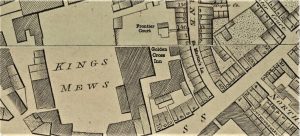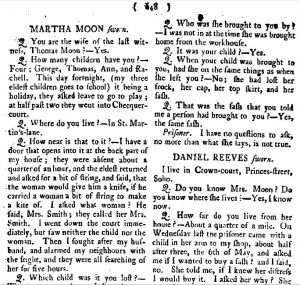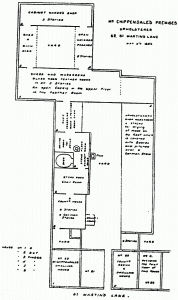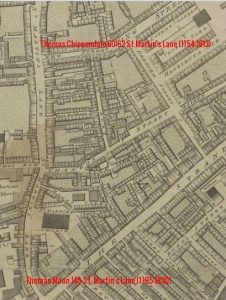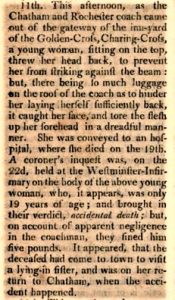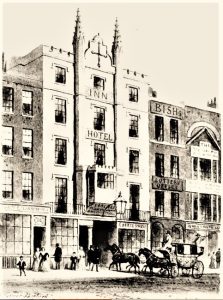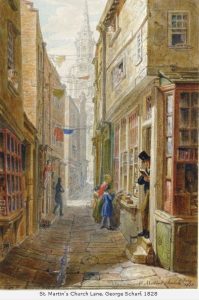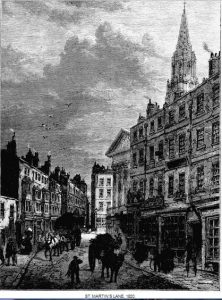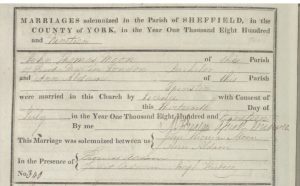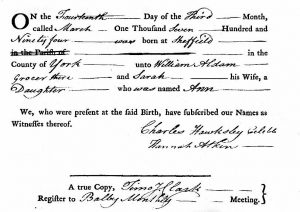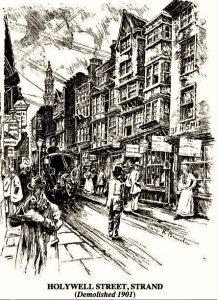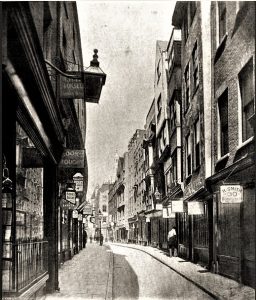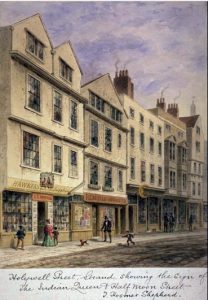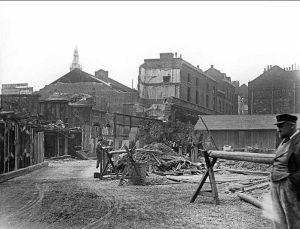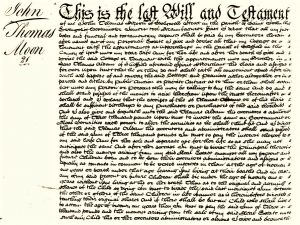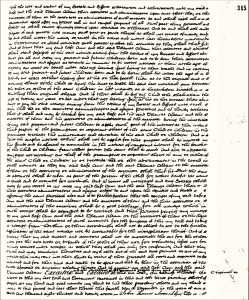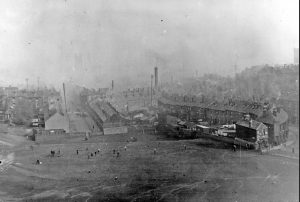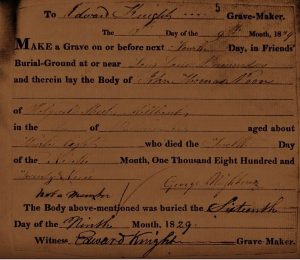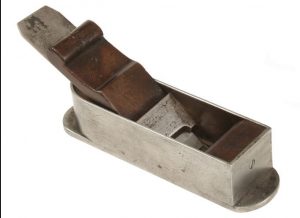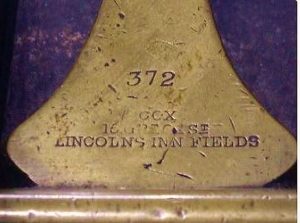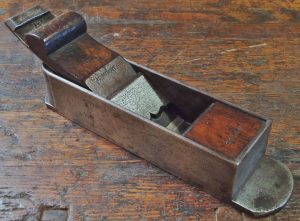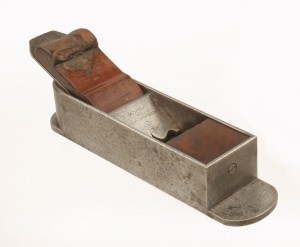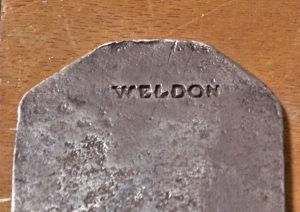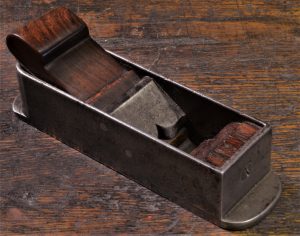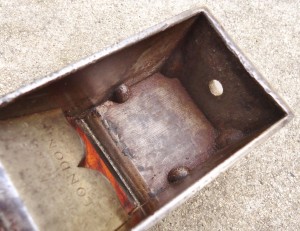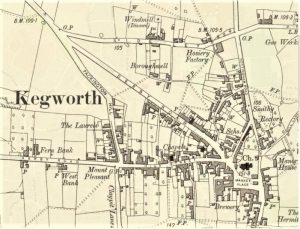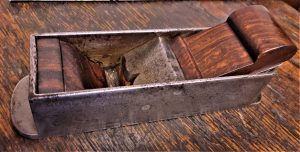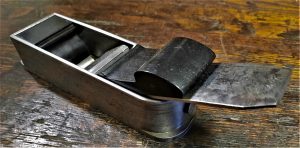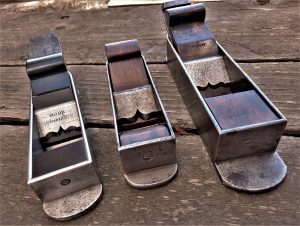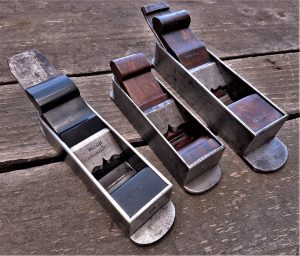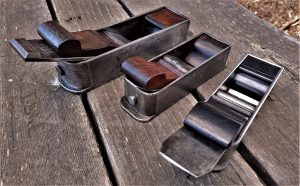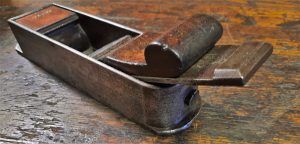MOON MITRE PLANES
© 2021 – Martin Shepherd Piano Service Using the text, research, or images on this website without permission on an ebay auction or any other site is a violation of federal law in most countries.
Thomas Moon, and later, son John Thomas Moon made planes and other tools from around 1795 to at least 1829. After John Thomas’ death, his wife Ann Moon, née Aldam (1794-1851) owned the retail operation located on 4 Little Queen St. from 1831 to 1848. Along with John Moseley & Son, the Moon business was one of the few tool warehouses in London that presented their tools in a true retail setting.
Thomas Moon, Cabinetmaker
Thomas Moon, born circa 1761 in Trowbridge, Wiltshire, married Martha Wilks (born 1757, died 18 October, 1841) of St. James, Picadilly, London, on 31 July, 1788.

Thomas & Elizabeth Moon, baptized 18 September, 1763, in Trowbridge. Wiltshire. Parents: William and Martha Moon, parish of St. James.
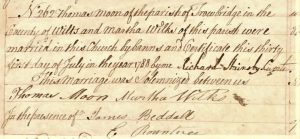
Thomas Moon of Trowbridge, Wiltshire married Martha Wilks of St. James, Picadilly, London, on 31 July, 1788.
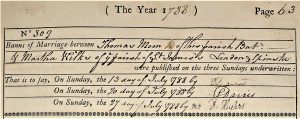
Banns of Marriage for Thomas Moon and Martha Wilks. Published 13, 20, 27 July, 1788, St. James, Trowbridge, Wiltshire.
John Thomas Moon, born 1 February 1791; Baptised 11 February 1791, at St. Martin in the Fields Church.
Plying the trade of a cabinetmaker, Thomas Moon established his and Martha’s home on Frontier Court, which was off of Saint Martin’s Lane, just north of the Golden Cross Hotel at Charing Cross. Thomas and Martha had a least 7 children, who were all baptised at Saint Martin in the Fields Church, just across Saint Martin’s Lane, on the east side of the Lane:
- George Moon, born 20 April, 1788, baptised 30 May 1788.
- John Thomas Moon, born 1 February 1791, baptised 11 February 1791. Died 12 September, 1829.
- Ann Gilson Moon, born 31 July, 1792, baptised 16 September, 1792.
- Rachel Umphleby Moon, born 29 June 1794, baptised 15 August, 1794.
- William Wilks Moon, born 16 April, 1797, baptised 1 June, 1797.
- Georgiana Moon, born 10 May 1801, baptised 29 June, 1801.
- Frederick Alexander Moon, born 16 August 1803, baptised 25 September, 1803.
Frontier Court, Saint Martin’s Lane (under construction)
On 18 August, 1790 Thomas Moon took out a Sun Insurance policy: “Thomas Moon Cabinetmaker, His wife [Martha Wilks] a Seamstress; Frontier Court, Saint Martin’s Lane” (Possible Map from Sun Documents)
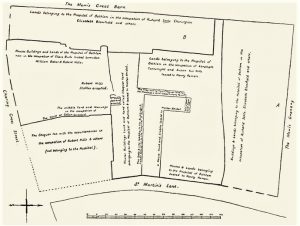
Land claimed by Bethem Hospital at Charing Cross, circa 1649. From “Survey of London: Volume 20, St Martin-in-The-Fields, Pt III: Trafalgar Square and Neighbourhood,” Edited by G H Gater and F R Hiorns (British History Online).
Frontier Court was located in the section marked “A” in this map of the land claimed by Bethem Hospital in the Charing Cross location.
Sarah Sims Kidnapped Two Year Old Ann Moon
This incident, and others like it, illustrated just how dangerous it was to live in London in the 18th and 19th centuries.
1795 Thomas and Martha Moon Old Bailey Online: SARAH SIMS was indicted for feloniously stealing, on the 6th of May , a linen frock, value 1s. a cotton skirt, value 1s. a linen cap, value 1s. 6d. and a silk sash, value 6d. the goods of Thomas Moon . But the really serious crime was that Thomas and Martha Moon’s youngest, 2 year, 9 month old daughter Ann, was kidnapped by Sarah Sims for part of a day.
Moon’s Tool Warehouse and Chippendale’s Saint Martin’s Lane Workshop
By 1795 Thomas Moon set up his original shop on St. Martin’s Lane at no. 145. The Moon Tool Warehouse remained at 145 St. Martin’s Lane until the area was cleared in 1830, for the building of Trafalgar Square. Earlier, Thomas Chippendale & Son also had a shop on this street, no 60-62 from 1754 until their bankruptcy in 1813. Chippendale wrote the influential book, “The Gentleman and Cabinet-maker’s Director,” which was a collection of furniture designs in Gothic, Chinese, and Rococo styles as well as domestic pieces. It was published in 1754. Chances that Moon and Thomas Chippendale Jr. never met would be close to none.
Thomas Chippendale’s Workshop at 61-62 Saint Martin’s Lane, was a large operation. Members of Chippendale’s large staff would have been good customers for the Moon Tool Warehouse.
Thomas Moon, “Carpenter’s Tool-Warehouse,” 145 Saint.Martin’s Lane, 1799 Holden’s London Trade Directory.
1800 Coach Accident at Golden Cross Inn
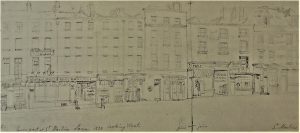
Storefronts on St. Martin’s Lane in 1830, including Thomas Moon’s retail store and entrance to the Golden Cross Inn. Drawing done by George Scharf.
In the “Pickwick Papers,” by Charles Dickens, in chapter II Mr. Jingle gave an account of a coach accident at the entrance to the Golden Cross Inn at Charing Cross. Here is Charles Dickens’ fictional account of the accident which was purported to have occurred, circa 1827:
‘Heads, heads–take care of your heads!’ cried the loquatious stranger, as they came out under the low archway, which in those days formed the entrance to the coachyard. ‘Terrible place–dangerous work–other day–five children–mother–tall lady, eating sandwiches–forgot the arch–crash–knock–children look round–mother’s head off–sandwich in her hand–no mouth to put it in–head of a family off–shocking, shocking! Looking at Whitehall, sir?–fine place–little window–somebody else’s head off there, eh, sir? He didn’t keep a sharp look-out enough either–eh, Sir, eh?’
The following quote came from the “Survey of London: Volume 20, St Martin-in-The-Fields, Pt III: Trafalgar Square and Neighbourhood,” Edited by G H Gater and F R Hiorns (British History Online). Gater and Hiorns described the low entrance to the Golden Cross Inn between 144 and 145 Saint Martin’s Lane:
[The Golden Cross Inn] had an entrance to St. Martin’s Lane between Nos. 144 and 145. It was from the Golden Cross that the immortal Mr. Pickwick started on his journey to Rochester and it is of interest to not that Mr. Jingle’s story of the lady who lost her head had some foundation in fact, for on 11 April, 1800, as the Chatham and Rochester coach emerged from the gateway of the Golden Cross “a young woman, sitting on the top. threw her head back, to prevent her striking against the beam, but there being so much luggage on the roof of the coach as to hinder her laying herself sufficiently back. it caught her face, and tore the flesh…in a dreadful manner” –an accident which afterwards proved fatal.
Here is the account in the “Annual Register” of the coach accident that actually occured almost 30 years earlier, on 11 April, 1800.
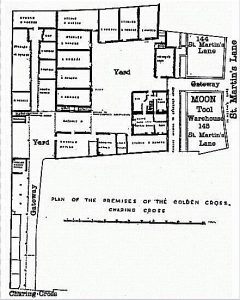
Golden Cross Inn, with entrance to St. Martin’s Lane and Moon’s Tool Warehouse. Drawing (modified) from British History Online.
The Golden Cross Inn had been established there since Elizabethan times. This hotel catered in large part to travelers who took stagecoaches throughout southern England. There were two coach entrances the hotel. The entrance at Charing Cross led to a small courtyard, and the entrance in Saint Martin’s Lane, between nos. 144 and 145 led to to a much larger, primary courtyard. Problem was, the St. Martin’s Lane entrance was very low, as seen in the George Scharf drawing from circa 1829.
The Charing Cross entrance had much more head clearance, as seen in the circa 1820 drawing by T. Hosmer Shepherd.
This drawing of St. Martin’s Lane was located a block south of St. Martin’s Church, looking north. The Moon Tool Warehouse would have been off to the left of the image.
Sun Insurance Policies (details forthcoming)
2 January, 1801 Sun Insurance Policy Thomas Moon, Carpenter and Ironmonger, 145 St. Martin’s Lane. (Include any relevant information/images).
29 January, 1817 Sun Insurance Policy Thomas Moon, Tool Warehouseman, 145 St. Martin’s Lane. (Include any relevant information/images).
15 March, 1819. Sun Insurance Policy John Thomas Moon, Tool Warehouseman, 145 St. Martin’s Lane. (Include any relevant information/images).
15 March, 1819. Sun Insurance Policy Thomas Moon, Barossa Place, Frimley, Surrey gent. (Include any relevant information/images).
Thomas Moon Barossa Place, Frimley
In 1810, with an eye for his future retirement, Thomas Moon bought property at Barossa Place, Frimley (now Camberley), in Surrey County. Thomas Moon’s land was located just north of London Road, and directly east of King’s Ride. At the time, Thomas Moon was still working and running his Tool Warehouse at 145 Saint Martin’s Lane, in London. Thomas continued to work running the Moon Tool business until 15 April, 1819, when his son John Thomas took over, and Thomas retired to Frimley. Land taxation records remain extant for the Frimley Property, called “York House” by Thomas Moon, from 1813 through 1830, the year of Thomas’ death.
Of the 7 known children of John and Martha Moon, only John Thomas and Georgiana were included in Thomas Moon’s will, written 20 March, 1824, and amended with a codicil on 21 February, 1826. At this point, I am not aware of how many of the Moon children of this generation survived beyond childhood. While generous arrangements in Thomas’ will were made for his wife Martha Wilks Moon, and Georgiana Moon, Thomas only left £20 for his son John Thomas. The reason for this paltry sum may have been because the transfer of wealth from father to son had already occurred in 1819, when the Moon Tool business changed hands. In any case, it was clear that from John Thomas’ will that he was better off financially than his father by a factor of 10. Just 3 months after taking over the business at 145 Saint Martin’s Lane, John Thomas got married.
John Thomas Moon married Ann Aldam of Sheffield on 13 July, 1819
John Thomas Moon, 28, traveled to Sheffield to marry Ann Aldam (born 14 March 1794) of Upperthorpe, Yorkshire, on 13 July 1819 (license procured 24 June). John Thomas brought Ann back to London with him.
Thomas Moon, in the 1820 Kent London Directory. An artificer was an archaic term for a skilled craftsperson.
William and Sarah Aldam, of Sheffield, Yorkshire, were Quakers.
Children of John Thomas Moon and Ann Aldam Moon
All of the births of John Thomas’ and Ann Aldam Moon’s children were recorded in in the Quaker’s Westminster Meeting House. Ann Aldam was raised as a Quaker, but John Thomas’ and Ann’s family belonged to the Anglican Church. The recorders in the Quaker records were quite diligent about writing “Not a member” in all the Moon family’s Quaker documents. Here are the birth and death dates of the children of John Thomas Moon and Ann Aldam:
10 June, 1820, Birth of Henry Moon at [78] Regent St., St John the Evangelist. Quaker Birth Registry. Died after 1881, as Henry’s wife, Ellen Margaret Brown, head of household, described herself as “Engineer–Wife,” in the 1881 U.K. census.
19 December, 1821, Birth of Sarah Moon at 78 Regent St., St John the Evangelist. Quaker Birth Registry. Died 22 July, 1865, Bedford.
15 June, 1823, Birth of George Washington Moon, Holywell St., Saint John the Evangelist. Quaker Birth Registry. Died 11 March, 1909, Brighton.
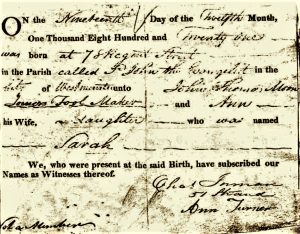
Sarah Moon, born 19 December, 1821, at 78 Regent St., St. John the Evangelist. Quaker Birth Registry.
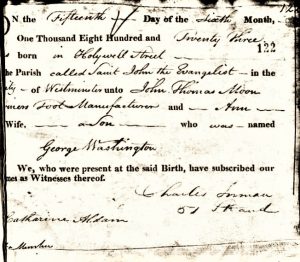
1823 15 June Birth of George Washington Moon, Holywell St., Saint John the Evangelist. Quaker Birth Registry.
29 March, 1825, Birth of Martha Moon, Holywell St. Quaker Birth Registry. Died 16 March 1907 Leicester.
15 March, 1827 15 March, Birth of Charles Moon. Holywell St. Quaker Birth Registry. Died 14 July, 1909 Croyden, Surrey.
10 February, 1829, Birth of John Thomas Moon Jr., Holywell St. Quaker Birth Registry. Probably died in childhood.
Until 1821, the Moon business was listed in the London Directories under Thomas Moon. From 1822 through 1828, John T. Moon, or just John Moon was listed at 145 St. Martin’s Lane.
The Moon family in the Notorious Holywell Street
John Thomas and Ann Aldam Moon lived in Holywell St. from 1823 to 1829, which was a short walk from 145 Saint Martin’s Lane. Many radical political books were published in Holywell street in the late 18th, early 19th centuries. By 1815, the local authorities began cracking down on what they saw as seditious activities. At that point, the publishing industry at Holywell began to sell pornographic books. As residents of Holywell St., the Moon family would have experienced firsthand, the transition from political manifestos to pornographic material. Legitimate publishers, however, were also plying their trade on Holywell Street. By 1835, there were around 50 publishers of pornograghy on this short one block long street between St. Clements and St. Mary’s at Strand. The street was run down and narrow: many of the buildings were from the Elizabethan era, and were designed with cantilevered upper floors, which leaned over the small street. Despite the fact that the area was described as being worn down and in disrepair, Holywell Street was shown to be populated by well off residents in Charles Booth’s 1890s Poverty Map of London.
This drawing of Holywell St. captured the closed-in surroundings and the furtive nature of the booksellers’ patrons.
Razing Holywell Street did not rid London of pornography.
Will of John Thomas Moon
1827 4 Dec. Will of John Thomas Moon. Proven 29 January 1830. Thomas Aldam and Ann Aldam Moon. At just 36 years old in 1827, John Thomas Moon may have been suffering from health problems which prompted him to write his will.
John Thomas Moon left his cottage in Upperthorpe, Sheffield, Yorkshire, to his wife Ann, for the rest of her days. John Thomas also left his savings of £3,000 (about $360,000 today) to his brother in law, Spirit Merchant, Thomas Aldam. Thomas Aldam was to use the interest generated by this capitol to provide for living expenses for Ann, for the remainder of her life. Additionally, the interest on £3,000 was to be applied to help provide for Thomas and Ann’s children until they reached the age of twenty.
It was unclear where John Thomas had made his £3,000. It could have come from his father Thomas, when the business changed hands, or it may have come in the form of a dowry from the Aldam family of Sheffield. Or John Thomas could have made a lot of money himself, because the early 19th century was a lucrative time to be selling high end craftworkers’ tools in a retail setting. Possibly John Thomas pieced together his savings from all of these sources.
Thomas Aldam died in Sheffield on 27 April, 1858, with a nest egg of almost £5,000. How much of that money (if any) might have come from John Thomas Moon?
This photo of Upperthorpe, taken ~70 years after John Thomas left his Upperthorpe cottage to Ann Aldam Moon, shows the industrialization of this neighborhood over the intervening years.
In 1829, John Thomas’ name was crossed out in the Westminster Rate books, which usually meant gone or dead.
John Thomas Moon died on 12 September, 1829, and was buried on the 16th. “Not a member” of the Society of Friends.
This burial was in a Quaker cemetery near Long Lane, Bermondsey St. in Southwark.
After the Death of John Thomas Moon

Sale of Golden Cross, Frontier Court, and Houses on St. Martin’s Lane to the Crown. From “The Gentleman’s Magazine,” Volume 149, c. 1831.
Ann Moon was forced to vacate her Tool Warehouse in 1830, because the neighborhood needed to be razed in order to clear space to build Trafalgar Square. When Ann Moon moved her tool warehouse to 4 Little Queen Street, Lincoln’s Inn Fields, she listed the business under John Thomas’ name in the 1831 Trade Directory.
As Ann Moon carried John Thomas’ name over to the new warehouse at 4 Little Queen Street, it was also seemingly apparent that she carried her late husband’s name over to her residence on Holywell St. John Thomas Moon[e] continued to appear on Holywell Street documents from before 1833 to after 1863. After further scrutiny, however, this was not Ann fronting the name of John Thomas Moon (1791-1829), or the name of John Thomas Moon Jr., (1829-?). It was yet another John Thomas Moon (or Moone, 1799-1865), at 8 and 9 Holywell Street, who was a herald and coach painter.

John Thomas Moone, and son John James Moon, Herald painters, at Nos. 8-9 Holywell St., in the 1851 U.K.census.
Since Holywell Street was only 1 block long, these two Moon families were almost certainly related. And there was a good chance that John Thomas and Ann Aldam Moon had lived at 8 Holywell St. from 1823 to 1829, and when Ann left Holywell St., before 1833, she left her residence to John Thomas Moone.

Ann Moon of “Independent Means,” living in East Leake, Nottinghamshire, along with her daughter Sarah Moon, in the 1841 U.K. census.
Sometime after the death of her first husband in 1829, and before the 1841 U.K. census, Ann Moon moved to East Leake, Nottingham, and befriended Henry Cartwright. Henry Cartwright owned a Lace Manufactory at Hound’s Gate, Nottingham in 1844.
Moving from London to Nottinghamshire would have been a major lifestyle change for Ann and Sarah Moon. East Leake is a town of 7,000 people today.
It was notable that only one of Ann’s children, Sarah Moon (b. 1821) was living with her in 1841. Given that Ann Moon would have been receiving income from both her business as well as the interest income from the £3,000 that John Thomas had left her (and possible rental income from her inherited house in Upperthorpe, Sheffield), Ann Aldam Moon would not have been hard pressed financially to pay someone to watch over her children. Also, Ann did not appear to spend a lengthy period of time (if any) at her inherited cottage at Upperthorpe, Sheffield which she received from her first husband, John Thomas Moon.
Financial independence also enabled Ann to employ Benjamin Huntsman to run the Moon Tool Warehouse at 4 Little Queen Street, Lincoln’s Inn Fields, Holborn, London. Benjamin Huntsman, obviously named after the pioneering inventor of cast steel in 1743, lived at 4 Little Queen St., and was recorded as living there with his family in the 1841 U.K. census. None of the Moon family members were recorded as living at or adjacent to 4 Little Queen St., in the 1841 U.K.census.
Sometime before 1841, Ann hired Benjamin Huntsman, a young wooden planemaker and toolmaker. Benjamin continued to work for Ann until at least 1848, presumably making wooden planes and various other tools for Ann Aldam Moon, and her Moon Tool Warehouse.
Some wooden planes with his mark read “HUNTSMAN LATE MOON 8 KING ST. HOLBORN.” This mark could have been made after Ann Moon died in early 1851, as Benjamin’s wife Mary was listed at 8 King Street from 1850 until 1863. From 1867 to 1876, Mary Huntsman’s tool business was listed at 16 Southampton Row.
Other contributions to Moon’s line of tool merchandise at 4 Little Queen St. could have come from their son Henry (born 10 June, 1820) after 1835. Expensive mitre planes may have been bought in and rebadged from Edward Cox, who was a close neighbor, at 26 Little Queen St. in the 1830s, and 15 Great Queen St. in the 1840s and early 1850s.
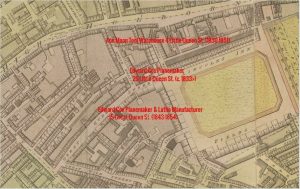
Detail of Richard Horwood’s 1792-99 Map of London, showing Moon’s Tool Warehouse (1830-1851) and planemaker Edward Cox’s workshops (1833-1854).
For the 1831 through 1848 listings at 4 Little Queen Street, John Moon’s name was omitted from the London Directory listings and sometimes Ann Moon’s name was added.
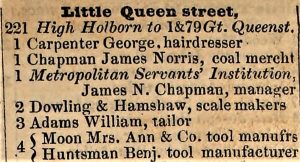
In the London Street Directory for 1847, Ann Moon and Benjamin Huntsman were listed together at 4 Little Queen Street, Holborn.
1848 was the last year for listing the Moon Tool Warehouse in the London City Directories
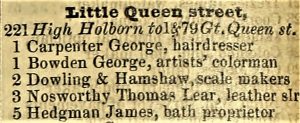
In 1849, 4 Little Queen Street was omitted, implying that the premises were unoccupied. This was also the case in 1850
This Moon mitre plane is visually similar to a Towell mitre until one lines the Moon up next to some Towells to see that they do not match. It is not known who made the mitre planes from 1829 to 1851, even whether or not they were made in-house by employees or bought in. Moon mitres also featured a Cupid’s bow on the bridge, as did many English makers of wrought iron mitre planes in the early 19th century.
Number 878 in Antique Woodworking Tools, by David R. Russell. 10 1/8″ long, with a 2″ iron by James Cam, set at 23 degrees. Dovetailed body, and two piece sole joined by tongue and groove. Typical metal plane construction of the period. Looks like a former owner used a screwdriver on the wedge when adjusting the iron.
This plane may appear to have a moveable front sole piece, for adjusting the throat, but that is not the case. Its built of cast iron sides, applied to a steel sole rear of the mouth. In front of the fine mouth, is a separate front sole piece that is pinned to the body through four internal lugs on the sides.
MOON 4 Little Queen St. Lincolns Inn Fields LONDON. Front infill removed, showing 4 internal lugs that are pinned through the sole from underneath. A separate sole going behind the mouth can be seen on the inner left cheek. This arrangement has left the mouth fairly fine after almost 200 years.
After the Closure of the Moon Tool Warehouse

George Washington Moon married Anne Stacey, at Saint James Church, Westminster, 20 July, 1853. Father John Thomas Moon: “Joiners’ Tool Maker, deceased.”
The paper trail for Henry, Sarah, George W., Martha, and Charles Moon picked up after 1850. John Thomas Jr. (born 1829) may well have died during childhood. Here is the marriage document for George Washington Moon in 1853, which included his father, John Thomas.
Martha Moon Married Thomas Chapman Browne Esq., on 19 December, 1854. From Nottinghamshire Guardian, 21 Dec., 1854.

Ann Moon, “Tool Maker’s Widow; Accountant,” with Henry and Martha Moon, and Henry Cartwright, 86 Side Ley St., Kegworth, Leicestershire, in the 1851 U.K. census.
Kegworth is a small town with around 3,600 residents, located 12 miles southwest of the city of Nottingham.
Ann Moon was staying at 28 Great Russell Street in 1852, before she married Henry Cartwright. Son George Washington Moon was a witness.
Sadly, Henry Cartwright died three years after marrying Ann Moon. Ann was widowed a second time.
Less than two years after the death of Henry Cartwright, Ann herself passed away.
Morbus cordis means ‘no more than heart disease,’ or death by natural causes. General anasarca 10 weeks means acute edema from head to toe for 10 weeks. Ann Aldam Moon Cartwright would have been 63, not 61. Henry Cartwright was a “Lace Manufacturer (Master).” Henry Cartwright owned a Lace Manufactory at Hound’s Gate, Nottingham in 1844. By 1847 Henry moved his factory to High Pavement, Nottingham.
Some More Moon Mitre Planes
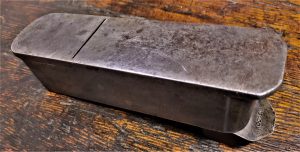
Cast 8 inch Moon 4 Little Queen St., Lincoln’s Inn Fields, view of sole, with fine mouth (for a cast bevel up plane).
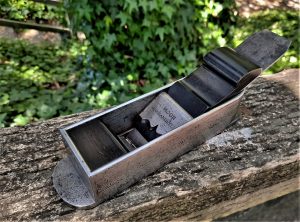
Moon mitre plane, 8 inches long, dovetailed, with ebony infill and Greaves iron. Stamped “145 Saint Martin’s Lane,” which would date it to pre-1830, or during John Thomas Moon’s lifetime.
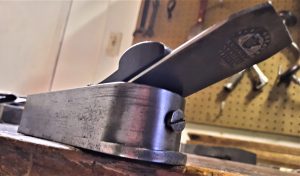
Moon mitre plane, 145 Saint Martin’s Lane, view of heel, with Greaves iron, rear flange, and cheesehead screw.
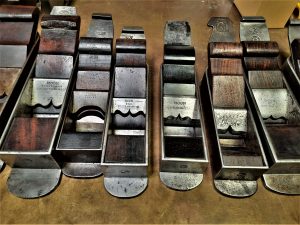
Moon 10″ 4 Little Queen St, Lincoln’s Inn Fields; Archer 9″ (Spiers); Buck 9″ 245 Tottenham Court Road (Towell); Moon 8″ 145 Sat. Martin’s Lane; Moon 8″ 4 Little Queen St. Lincoln’s Inn Fields, London; Buck 245 Tottenham Court Road (Holland). Mitre planes from the collection of James Claussen (with the exception of Moon 145 Saint Martin’s Lane).

